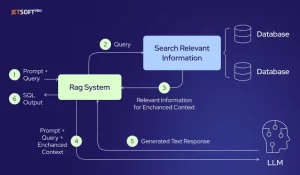In today’s data-driven world, the ability to quickly retrieve and manipulate information from databases is a must. However, interacting with databases can be tricky, especially if you don’t have technical expertise. That’s where Text-to-SQL technology comes in.
Text-to-SQL (or Text2SQL) is an advanced natural language processing (NLP) technology that allows users to convert plain language queries into SQL (Structured Query Language) commands. This makes it easier for anyone to interact with databases and retrieve the information they need.
For example, instead of having to write complex SQL queries to your sales database, you can simply ask a question like, “How many products were sold in September?” and the system will automatically generate the correct SQL query for you.

How Text-to-SQL Technology Works?
The process of converting natural language queries into SQL consists of 4 key steps:
1. User Input
The user asks a question in natural language. It can be anything from “What’s the revenue for product X?” to “How many customers signed up last month?” This input can be in any language, making it both intuitive and accessible for a wide range of users.
2. NLP Processing
Once the query is received, the system uses Natural Language Processing (NLP) to understand the user’s intent and context. This involves several steps:
- Tokenization: The query is broken down into smaller parts, or tokens, making it easier to analyze and search for relevant data.
- Named Entity Recognition: The system identifies key elements in the query, such as dates, product names, or other important terms that need to be included in the SQL query.
3. Query Generation
Using the information from the NLP processing, a large language model (LLM) that has been trained on the organization’s data generates the SQL query. The model ensures that the query is both accurate and syntactically correct, ready to be executed against the database.
4. Execution
The SQL query is executed on the database, and the results are returned to the user.
Seems simple, right? In reality, building effective Text-to-SQL systems is much more complex than it might appear at first glance.
2 Levels of Complexity in Text-to-SQL Applications
Text-to-SQL technology can vary significantly in complexity, depending on the type of dataset it operates on. Understanding these levels is key to evaluating its practical application in real-world scenarios.
Text-to-SQL on Pre-Curated Datasets
This is the simpler approach. The data is already organized, with clearly defined columns and relationships. The system just needs to match the user’s question to existing columns and generate SQL statements, such as simple SELECT queries with basic clauses like GROUP BY and FILTER. These queries typically work with one or a few pre-curated tables, making the task straightforward.
Building Datasets from Raw Tables
This approach involves generating SQL queries from scratch, using raw, un-curated tables. The system must not only understand the data structure but also the relationships between tables. This requires a deeper level of intelligence and precision, making the task more challenging and nuanced.
It gets even harder when the data comes from private or domain-specific sources like APIs, SQL databases, PDFs, or slide decks. In these cases, Retrieval Augmented Generation (RAG) presents a promising alternative. By supplementing the input context with additional information or data, RAG enhances the model’s understanding and performance, resulting in outputs that are more accurate and contextually relevant.
READ: AI Call Center: Opportunities and Risks
How RAG Enhances Text-to-SQL Technology?
RAG takes Text-to-SQL to the next level by retrieving contextually relevant information from various sources (e.g., databases, documents, APIs) before generating the query.
Here’s how RAG works in Text-to-SQL:
- Contextual Data Retrieval
The system uses vector databases to perform similarity searches, identifying the most relevant information from various sources like databases, documents, and APIs. This ensures the system doesn’t just extract keywords, but also understands the meaning behind the query, which makes the SQL query more accurate.
- Data Enrichment
Once relevant data is retrieved, it’s enriched with additional context. This step ensures that the system has all the necessary information before generating the SQL query.
- Query Generation
The enriched data is then processed by a large language model (LLM), which generates a precise SQL query based on the complete context.

Chaining with LangChain in Text-to-SQL Workflows
LangChain enhances Text-to-SQL workflows by allowing you to chain different processes together. This technique is invaluable when creating sophisticated workflows that link data retrieval, query generation, and execution in one seamless chain.
With LangChain Expression Language (LCEL), you can automate multiple steps like:
- Extracting relevant data
- Generating accurate SQL queries
- Enriching the context before query generation
LangChain also supports off-the-shelf chains, which can be customized for various needs. For example, create_sql_query_chain automates SQL query generation based on natural language inputs, while create_extraction_chain_pydantic extracts data based on predefined schemas.
By combining Chaining and RAG, LangChain ensures that the generated SQL queries are contextually precise and optimized. It integrates with ChromaDB for metadata storage and filtering, and OpenAI embeddings for search indexing, making the entire process more efficient and accurate.
In practice, this means you can create chains that:
- Automatically identify the relevant tables and columns
- Build complex queries (including joins and filtering)
- Execute them efficiently against the database
This approach simplifies Text-to-SQL tasks, making them more scalable, flexible, and accurate.
How JetSoftPro Can Help
At JetSoftPro, we specialize in implementing cutting-edge Text-to-SQL solutions. Our expertise includes integrating advanced AI tools, large language models, and RAG-based systems, ensuring that we can create tailored solutions for your data needs.

